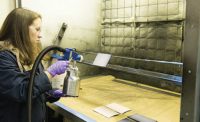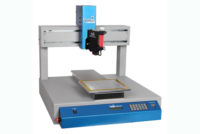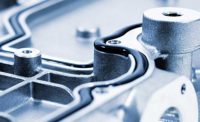Eliminating waste is a key part of lean manufacturing initiatives. It’s also important when it comes to using adhesive.
Dispensing is inherently wasteful. Some waste is unavoidable. Every dispensing process is going to have some kind of material waste, whether it is the priming of a pump or material left in supply vessels or hoses. For example, a small amount of unused adhesive will always remain inside a mixing nozzle at the end of a run.
Adhesive comes in some kind of a container, such as a bucket, cartridge, drum, pail, squeeze bottle or syringe. There’s always some efficiency loss, due to leftover material.
While waste is associated with dispensing, there are ways to minimize it. Often, excessive waste can be avoided through operator training or by investing in automation. Fortunately, suppliers of dispensing equipment have developed ways to address the issue.
“In all dispensing applications, there is going to be some type of fluid waste,” claims Tom Muccino, sales manager at Nordson EFD. “Manufacturers can minimize that waste by using the proper dispensing components.
“For instance, if someone doesn’t use a piston inside their syringe barrel reservoir, they will leave residue on the inside walls of the device, which creates a fair amount of waste,” explains Muccino.
“Using the proper piston will wipe the inside walls clean, greatly reducing the amount of waste,” adds Muccino. “[Our] SmoothFlow pistons are manufactured with precise tolerances to the inside walls of the syringe, ensuring that 99 percent of the fluid in the syringe reservoir will be dispensed.”
Manufacturing engineers are now focusing greater attention on waste than in the past, because materials have become more expensive and dispensing equipment has improved. By controlling dispense processes, they can cut costs and optimize materials.
“Improvements have occurred in the past five to 10 years,” says Jamie Ellsworth, president of KitPackers. “There is now [more interest in reducing] waste for both environmental and cost reasons. To maintain quality, worker safety and reduce waste, better dispensing equipment is being used and less manual mixing is being employed.”
“There was definitely more waste a decade ago,” adds Muccino. “Recent improvements to both dispensing components and dispensing equipment have achieved a higher degree of precision, which minimizes waste.”
The EFD Ultimus V dispenser is a good example. It uses regulators and timers, coupled with dispensing software, to increase precision and minimize waste. Dispensing valves such as the xQR41 MicroDot feature zero dead fluid volume, which means there is a minimal amount of material retained in the valve.
“This results in less waste in high-volume applications,” claims Muccino. “If you mount the valve to a dispensing robot, you get the added benefit of accurate, repeatable deposit placement, which leads to less rework and rejects, which [results] in less fluid waste.”
According to Muccino, choosing the wrong type of adhesive dispensing components can create waste. “For example, there are a number of different pistons that can be used for any dispensing application,” he points out.
“The choice of piston an operator uses can make a big difference in the amount of waste in the application,” notes Muccino. “Using air-powered dispensers with inaccurate air regulators can contribute to the waste. Dispensers equipped with precision regulators [will produce] the most accurate dispense.”
Sources of Waste
Several factors create waste in adhesive dispensing applications. For instance, a certain amount of oozing or dripping will occur after every dispense.
Another common source of waste is applying excess material to each part. That type of operator error is often associated with manual assembly applications.
“We still see customers put down ‘just a little’ more adhesive to be on the ‘safe side,’” says Patrick Kieselbach, sales manager at ViscoTec America Inc. “Human nature is to think that ‘more is better.’ That’s why automation can greatly reduce waste. It can guarantee that your dispense is going to be within ±1 percent of what it is programmed for.
“When production volumes are higher, there tends to be much less waste than with shorter runs,” notes Kieselbach. “That’s because the dispensing process is going to be much more dialed in.
“But, when you throw out a dispensing tip, there’s always going to be some material left in it,” adds Kieselbach. “Most waste, however, occurs before the point of dispense.
“One mistake that I see engineers make is using feeding lines or hoses that are too long,” warns Kieselbach. “Keeping supply lines as short as possible will help minimize waste.”
“Even with automated dispensing systems, there’s a certain amount of startup waste that occurs,” says Mac Larsen, director of application development for the applied fluid technologies division of Graco Inc. “For instance, there’s some temperature conditioning and initial purging that takes place.
“Changeover also is a major source of waste,” Larsen points out. “If you start and stop production throughout a shift, there will be material loss. Once you change out a material, there’s always an air lock that needs to be purged via a venting process.”
“Changeover is the No. 1 culprit of waste in adhesive dispensing applications,” claims Christian Geier, general manager at Scheugenpflug Inc. “When emptying a bucket or a container, it can be difficult to get it completely clean. And, after you change over, there’s normally an air bubble in the line, so you have to purge the old leftover material.”
Scheugenpflug recently developed the A90 CV expulsion unit to reduce cartridge changeover rate.
“For adhesive bonding, sealing and thermal management tasks with low media consumption, material is usually provided with commercial cartridges,” says Geier. “Optimally tailored feeding systems guarantee a gentle and constant material feed—even when processing small volumes.
“The A90 CV not only guarantees a reliable and failure-free feed of highly viscous media to the dispenser, but also features a new vacuum docking function,” explains Geier. “For the first time, this enables automated ventilation during cartridge changes and, thus, an absolutely bubble-free docking process of the material cartridge to the dispensing system.
“[Typically], freshly mounted cartridges [are] ventilated manually, meaning that the accompanying material loss is dependent on the routine and experience of the operator,” adds Geier. “Since this process happens automatically now when using the vacuum docking function, the material waste per cartridge change can be reduced by up to 90 percent. In addition to maximum process reliability, users also benefit from significant cost savings—especially when using very expensive materials.”
Waste Variables
Waste can vary based on the type of material being dispensed, the size of parts and even the type of industry.
“The automotive and electronics industries tend to be the most efficient when it comes to using material,” says Larsen. “The least efficient industry that I see is boat manufacturing. There are shorter production runs, more manual assembly processes and a ‘more is better’ mentality when it comes to using adhesive.”
Certain types of adhesives are also more prone to waste than others.
“Generally speaking, you can get more waste with a high viscosity fluid compared to a low viscosity fluid, because it can be more difficult to push thicker fluids out of a syringe reservoir while wiping the side walls clean,” says Muccino. “Materials like epoxy, silicones, greases and solder pastes can be very tacky.
“When dispensing these materials, it is important to use the proper piston inside the syringe reservoir that will not only help with accurate dispensing, but will dispense everything that is in the syringe,” Muccino points out. “A piston with wipers will wipe the inside of the syringe clean, but a flat-walled piston will leave a slight residue inside the syringe.”
“Every fluid reacts differently when dispensing,” says Omar Regalado, director of global sales at Fishman Corp. “But, one of the materials that waste is more common with is epoxy.
“The most popular epoxies have a short pot life,” explains Regalado. “Due to the nature of the fluid, it becomes difficult to maintain repeatability and accuracy while the material is changing viscosity during the dispense, which causes fluid waste. Also, once the epoxy is mixed, the pot life starts, and if the material is not dispensed within the material’s working life, you are forced to throw away the remaining fluid.”
According to Regalado, waste occurs more frequently when bonding small parts that require less adhesive. “Typically, the smaller the amount required for an application, the tighter the tolerance,” he points out.
“Applications that require smaller dispenses require more accuracy from dispense to dispense,” claims Regalado. “It’s common to see over-dispensing on these types of applications, which results in fluid scrap, rework and more fluid waste.”
More waste also typically occurs with two-part adhesives.
“Materials that are reactive, such as two-component epoxies, will require periodic mixer change outs or purging of materials to maintain fresh material in dispense nozzles,” says Larsen. “Other adhesives that create more waste are single-component moisture or heat-cure materials like silicones and the isocyanate portion of polyurethanes.”
“Any dual-component adhesive, regardless of chemistry, is going to have more waste than a single component adhesive,” adds Ellsworth. “Moisture-sensitive adhesives like polyurethanes will potentially have more waste if precautions to protect them from moisture are not taken.
“With dual-component adhesives, most waste arises from manual weighing and mixing in batches and trying to get it into or onto a part during its work life,” says Ellsworth.
“With a manual application, it is also more difficult to apply the correct amount of adhesive,” explains Ellsworth. “There is an optimum bond line thickness and any additional adhesive used is waste.
“Dual-component adhesives with very short work lives also create more waste, because the static mixer needs to be purged or the adhesive is too far advanced to be applied,” Ellsworth points out.
The Great Debate
Exactly how much waste occurs during adhesive dispensing depends on several variables.
“There will always be about 2 percent to 3 percent of the adhesive that will remain in the original container,” says Ellsworth. “The thicker the adhesive, the higher the loss due to [material clinging to the sides of] the container.
“If the adhesive needs to be repackaged into cartridges for dispensing, then you waste another 2 percent to 3 percent in the filling equipment for setup and adhesive left in metering valves and cylinders,” Ellsworth points out.
“If it is a dual-component adhesive, then you will have additional waste in the static mixer and material purged to obtain phasing,” adds Ellsworth. “With meter-mix equipment, you waste material in calibration and setup. The highest cumulative waste we encounter is 10 percent, but our goal is more like 5 percent by weight.”
“Even with the best equipment, 3 percent waste is a reasonable number,” says Sebastian Wagner, a sales engineer at Scheugenpflug. “But, it depends on the application. For instance, we’ve seen some automotive manufacturers that waste up to 20 percent of their material.
“Silicones in particular can cause problems,” notes Wagner. “You can easily contaminate an entire bucket and then have to throw it all away.”
“As a general rule of thumb, more waste occurs with manual dispensing applications,” claims Wagner. “With automation, you only dispense the amount that you need. It improves accuracy and ensures complete coverage. You can dial in the equipment to 0.1 millimeter dispensing accuracy and 0.02 millimeter X-Y-Z directional accuracy. Automated dispensing systems also enable continual purging at set time intervals.”
“Waste always occurs with adhesive that’s left over in a container,” adds Graco’s Larsen. “Based on this residual material alone, you’ll end up with at least 1 percent to 5 percent waste.
“If you have 2 percent of material left over in a 55-gallon drum that weighs 450 pounds, then that’s 9 pounds of waste,” says Larsen. “The dollar amount of that loss depends on whether that material costs $2 a pound or $20 a pound. For instance, cyanoacrylates would generally be more expensive than silicones.
“Eventually, any type of container that your adhesive comes in is going to be empty,” says Larsen. “But, it’s not going to be 100 percent empty.”






